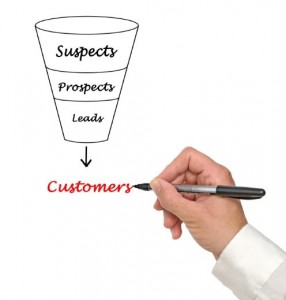I’m fascinated by all things marketing, but I know many other SME owners don’t share that fascination. Some are (understandably) confused by the terminology sales and content marketing people use, so I thought this week I’d try to concisely explain some of the most important concepts.
If you’re struggling to generate leads, increase website traffic, and gain clients, then understanding these concepts could help you diagnose the problem and change direction to head for success. I’m sure many marketing and sales people will disagree with some of my interpretations below, but I’m not going to get hung up on definitions – the aim is to shine a light for those who aren’t involved in sales and marketing, or at least not willingly involved!
1. The sales funnel
If you search online, you’ll find many different interpretations of the sales funnel. At its most basic it looks like this:
 It’s important to understand the funnel concept because it ties in with some very fundamental factors that determine your success. To quickly understand how, look at the picture (left) and replace ‘Suspects’, ‘Prospects’ and ‘Leads’ with ‘Brand Awareness’, ‘Researching Options’, and ‘Make an Enquiry’.
It’s important to understand the funnel concept because it ties in with some very fundamental factors that determine your success. To quickly understand how, look at the picture (left) and replace ‘Suspects’, ‘Prospects’ and ‘Leads’ with ‘Brand Awareness’, ‘Researching Options’, and ‘Make an Enquiry’.
Top of funnel = brand awareness
Quite simply, if your prospective clients don’t know you exist, they can’t possibly become leads or customers. What this suggests is that creating brand awareness should be an exceptionally high priority for any new business.
Keep in mind, that creating brand awareness is the initial stage – just because people know you exist doesn’t mean they’re ready to order.
Our business sign is positioned on a main road and 2000 cars pass per hour on our side of the road – many people I’m introduced to say: “Oh, I’ve seen your sign.” That’s brand awareness, but it doesn’t immediately translate into leads or customers.
Middle of funnel = researching options
‘Researching options’ could also be replaced with ‘Looking for a Solution’.
This is when clients are searching online to see how other people have solved their problem, what options are out there, or who has the right expertise. They might be simply looking for information, or they might be comparing services or products. Generally speaking, they’re on a fact finding and information gathering mission. It’s at this point that any efforts you’ve put into creating brand awareness can pay off.
It can also pay off if your content comes up prominently in Google’s search results when your prospective clients are looking for answers or information. Keep this in mind when you’re choosing or approving topics for your article writers to work on, writing your own material, or briefing copywriters who will be creating copy for your website. Do a little keyword research to identify the type of questions people are asking and the range of keyword phrases they are using when searching for information in your niche.
Bottom of funnel = leads
Having done their research, your prospective client is ready to make an enquiry – they’re now displaying an active interest in what you have to offer.
Over to you to turn them into customers.
2. Social selling
People seem to get into quite a tizz over the definition of social selling, but it boils down to this: using social media engagement to generate leads and find customers. For example, you might be described as social selling if you:

- Actively engage with others on LinkedIn, build up connections, publish and communicate, in a way that results in generating leads and winning customers.
- Build an audience on Twitter and engage in conversations in a way that generates leads.
If you’re a B2B and you’re not even attempting to do this, you’re certainly missing out on leads and sales.
Where the tricky bit comes in, is in doing it properly. Spamming people by pitching your services uninvited or seeking connections then immediately sending a cringe-worthy sales pitch won’t cut it. These platforms are about engaging in genuine conversations and building relationships over time – a bit like person to person networking at its best.
The last two concepts feed into the next.
3. Audience building
It turns out that online and offline aren’t so very different. The person who is a dynamite networker in person and has established hundreds of contacts, friends and acquaintances they can share information with, invite to events, or ask for recommendations, has established an offline audience. They have a massive number of people aware of who they are and what they do.

And if you know anyone like that, you’ll know that they’re forever on the phone, accepting and giving invitations, offering and receiving advice, giving and getting recommendations and referrals.
Now, transfer that concept to the online environment. Your social media channels are for exactly the same purpose. And when people find what you have to say or share interesting, they begin to follow you. As more people follow, connect or engage with you on social media channels, your audience grows.
The benefit of building your audience is that when you have something to say or share, more people are listening, potentially passing that information along, and growing your audience/network further.
Building an audience should be a high priority – it helps you to create brand awareness, it provides the engagement you need for social selling, and importantly, when you post a blog the size of your audience will determine whether 2 or 200 people will ever see it.

4. Inbound marketing (aka content marketing)
This final concept incorporates all of the above.
Inbound marketing, which you might also hear referred to as content marketing, is the practice of marketing in a way that draws clients to you – as opposed to having a team of sales reps cold calling and knocking on doors.
The way we make purchasing decisions has changed over the past few years. When we’re looking for a new solution or trying to work out how to do something, we take to the internet to research it.
At that early stage we’re likely to come across content created by a business on the subject of interest, and if that content impresses us we might take another step in our journey.
That step might be to subscribe to a blog or newsletter that covers topics of interest to us, download an eBook for more detailed information, or if we’re further along in our decision making, we might even be ready to send off an initial enquiry.
Once we’ve subscribed, downloaded or sent off that enquiry, that business has us on their database, and we’ll probably receive regular updates or information, or perhaps a special offer. And when we’re ready to buy we might not feel we need to return to the internet to look further at our options – because we’re already engaging with a supplier who provides a wealth of information via their content and is beginning to look like the obvious choice.
Joining the dots
Trying to understand how all these concepts play into each other might give you a giant headache. But joining the dots and reaching out to capture the attention of your target market/prospective clients when they’re close to the top of the funnel can establish relationships at an early stage.
This dramatically increases the chances that, when prospects are ready to make a purchasing decision, they’re already moving down your funnel instead of your competitors’.
Warning: Inbound clients!





